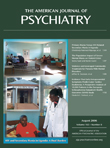Lifetime and 12-Month Prevalence of DSM-III-R Disorders in the Chile Psychiatric Prevalence Study
Abstract
Objective: Although several epidemiological studies of the prevalence of psychiatric disorders have been conducted in Latin America, few of them were national studies that could be used to develop region-wide estimates. Data are presented on the prevalence of DSM-III-R disorders, demographic correlates, comorbidity, and service utilization in a nationally representative adult sample from Chile. Method: The Composite International Diagnostic Interview was administered to a stratified random sample of 2,978 individuals from four provinces representative of the country’s population age 15 and older. Lifetime and 12-month prevalence rates were estimated. Results: Approximately one-third (31.5%) of the population had a lifetime psychiatric disorder, and 22.2% had a disorder in the past 12 months. The most common lifetime psychiatric disorders were agoraphobia (11.1%), social phobia (10.2%), simple phobia (9.8%), major depressive disorder (9.2%), and alcohol dependence (6.4%). Of those with a 12-month prevalence diagnosis, 30.1% had a comorbid psychiatric disorder. The majority of those with comorbidity had sought out mental health services, in contrast to one-quarter of those with a single disorder. Conclusions: The prevalence rates in Chile are similar to those obtained in other studies conducted in Latin America and Spanish-speaking North American groups. Comorbidity and alcohol use disorders, however, were not as prevalent as in North America.



